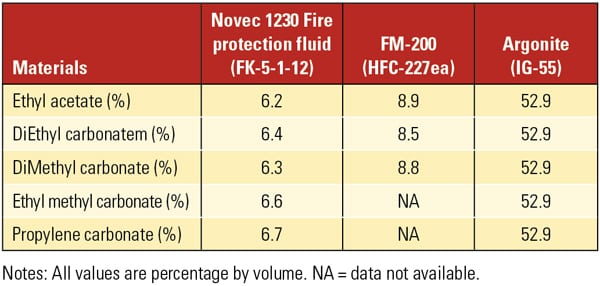Lithium-Ion Batteries: A Potential Fire Hazard
The proliferation of battery technologies in modern industry is presenting fire professionals with new sets of challenges. Confusion exists as to the correct approach for protecting industrial batteries from fire, whether that be in battery manufacturing, battery storage, or battery-powered applications.
Lithium-ion (Li-ion) cells are distinctly different from lithium (primary) cells and are used in large numbers in power grid stabilization systems, containerized battery systems, and other large-scale applications. These types of systems have thousands to tens of thousands of Li-ion cells integrated into a single space. The uses of Li-ion cells in these applications need to be reviewed for potential fire hazards, and fire protection strategies must be applied and implemented to reduce the risk (Figure 4).
 |
| 4. Be aware of new fire risks. Industrial use of Li-ion batteries has grown substantially over the past few years, but knowledge of appropriate fire protection agents has not kept pace. Courtesy: Kidde Fire Systems |
Potential fire protection strategies include using gaseous fire suppression agents, such as FM-200, 3M Novec 1230 fire protection fluid, and/or Argonite to protect large arrays of Li-ion cells.
What You Should Know About Li-ion Batteries
Li-ion batteries do not contain lithium in its metallic form. Therefore, these batteries do not pose a Class D fire risk, as compared with batteries that do contain metallic lithium.
Electrolytes used in Li-ion batteries are complex formulations consisting of lithium salts, such as LiPF6, LiBF4, or LiClO4 in an organic solvent, such as ethylene carbonate (EC), dimethyl carbonate (DMC), diethyl carbonate (DEC), or ethyl acetate (EA). A liquid electrolyte allows movement of lithium ions between the cathode and the anode when a battery passes an electric current through an external circuit.
If overheated or overcharged, Li-ion batteries can suffer internal mechanical damage, leading to electrical shorting and internal heating. Overheating and overcharging can also result in a thermal runaway event that can lead to cell rupture and leakage of combustible electrolytes. Electrolytes are Class B materials (flammable liquid) and the design concentration should be determined by test for the particular composition present.
Fire-Extinguishing Solutions
Rupture of Li-ion cells may result in the ejection of electrolyte, a Class B flammable or combustible liquid. Gaseous agents will extinguish flames due to burning leaked electrolyte but have little or no effect on mitigating or preventing a thermal runaway occurring within Li-ion cells. These reactions are internal to the cell, and although the charging array will likely have preventative measures incorporated into its design, the reaction may still occur.
Despite the potential for Class B material discharge, there are two possible approaches to the use of a gaseous fire suppression agent for hazards involving Li-ion batteries:
- Based on a risk assessment, hazard survey, and customer/end user strategy, protect the space based solely on the Class A materials present and/or the Class C energy source(s). This approach chooses not to specifically protect against the Class B (electrolytic material) contained within the battery, which would only be introduced into the hazard upon a catastrophic failure of the battery cell itself.
- Based on a risk assessment, hazard survey, and customer/end user strategy, protect the space based on the Class A materials present, the Class C energy source(s), and the Class B (electrolytic material). This approach provides protection in the event that ejection of the electrolyte material occurs, which could ignite if an ignition source is present.
Cup burner and other tests were completed in accordance with the requirements and guidelines of NFPA 2001 (2012 edition). Based on the results of these tests, Kidde Fire Systems has determined the minimum agent design concentration necessary to suppress a fire involving some of the most commonly used Class B compounds found in electrolytes (Table 1).
 |
| Table 1. Several fire protection agent options. This table presents the appropriate fire protection agent and the mixture needed to suppress a fire involving the most common types of materials found in Li-ion batteries. Source: Kidde Fire Systems |
The growing use of Li-ion batteries in industrial and other large-scale applications requires an increasing awareness of the potential fire hazards posed by such batteries and the most effective fire protection systems to mitigate the risk.
—Contributed by Jonathan Ingram, director of product marketing–Kidde Fire Systems, part of UTC Climate,
Controls & Security.